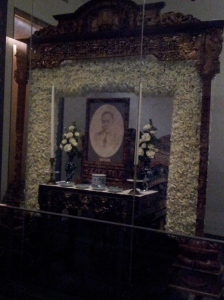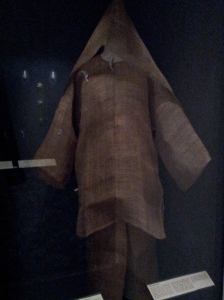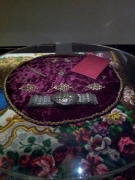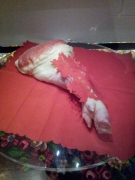Location: The Peranakan Museum
Address: 39 Armenian Street
I visited the Peranakan Museum last Friday and I was intrigued by the things I’d found out. 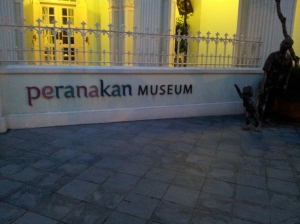
History of Peranakan Museum
The Peranakan Museum was originally called the Tao Nan School Building. It completed construction in 1912, which means the building is 100 years old! It was occupied by the Japanese army during World War 2, however, Tao Nan reopened two months after the Japanese surrendered. Due to rising number of pupils enrolling into the school after the war, Tao Nan decided to relocate to Marine Parade, where a new building with modern facilities will be beneficial in teaching the students. Hence, in 1972, Tao Nan handed over the building and relocated. The school at Armenian Street was converted to a museum. At first, due to it being an old Chinese school, it exhibited the different aspects of the Chinese culture. It then permanently focus on the heritage and culture of the Peranakans.
What/Who are the Peranakans?
The original word, Peranakan, actually meant “locally born” or “child”. There are different types of Peranakans, something that I just found out during my trip to the museum. There are Jawi Peranakans, Chitty Melaka (Peranakan Indians), Tsinoys; an ethnic group of mixed Chinese and Filipino or Spanish ancestory, Peranakan Chinese and also Peranakan Eurasians.
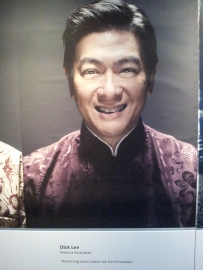 Do you know that Dick Lee is a Malacca Peranakan? I just know recently!
Do you know that Dick Lee is a Malacca Peranakan? I just know recently!
Significance of the culture
The Peranakan culture is significant in Singapore. There are many places in Singapore where they retain shop houses belonging to the Peranakans along Joo Chiat and Katong, shops and museum in Armenian Street dedicated to showcasing the culture as well.
Practice: Tok Panjang
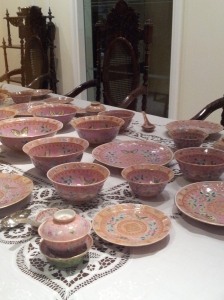 Dining wares used for Tok Panjang
Dining wares used for Tok Panjang
Tok Panjang is a Baba Malay term that refers to a type of feast associated with weddings and special occasions. “Tok” is the Hokkien word for table while “Panjang” is the Malay term for long. It was usually a luncheon feast attended by close relatives and friends, and consisted of food and desserts specially made for the occasions. The Tok Panjang is a mix of Eurasians, Chinese and Malay elements. The oldest style of Tok Panjang feast was done at weddings with dining tables extending from the ancestral altar. This signifies the addition of new members to the family. I believe that the Tok Panjang was practiced to bring closeness to the family, relatives and friends.
Ritual: Funeral Ritual
Like funeral rites, mourning (tua ha) in the Peranakan family was also rooted in the Chinese tradition as a filial piety. The traditional period of mourning was three years but daughter-in-laws had to mourn for an additional four months, as a symbolic act to repay the dowry money accepted by her family. This could be to serve as a reminder to the widow that although her husband was dead, she shouldn’t easily move on hence, that explains the long mourning period.
During the mourning period, there were many changes you can see in the home and also to the family’s daily routine. White lanterns would be hung; if one spouse was still alive, only one white lantern was hung up. By its position, passers-by would know whether the deceased was the husband or wife. House plaques (ji-ho) were also marked with a white “X” to indicate death in the family.
Belachu (sackcloth) worn during the wake and funeral.
After the funeral, they wore black for the first year of the mourning period. Gradually, mourning clothes changed from black to blue to green and finally, light yellow, orange or pink on the blue and green background. Peranakan women wore red ixora flowers in their hair to mark the end of the mourning period. When I went into the Death gallery, I was spooked. That was because they played a recording of the Peranakans mourning and weeping for the loss of their loved ones. I was surprised that Peranakan women wore jewellery even during the deaths of their loved ones.
Visible features of a wedding ceremony: Wedding gifts
Here, there were some wedding gifts presented to the bride from the groom. The first image is the dowry. The jewellery given was usually a set consisting of a kerosang, earrings, bracelets, belt & buckle and a ring. The red packet contained a sum of wang tetek (dowry money). The amount given was usually in multiple of six, which was an auspicious number for the Peranakans. I think the dowry money was called wang tetek because women used to keep money in their bra strap, that was probably why it was called wang tetek. The second image is an image of a leg of pork. Pork was an important sacrificial meat to the Peranakans and was used in important occasions such as weddings and as food offerings on the ancestral altar. By giving a leg of pork, it meant the groom’s family accepted a virgin bride. The bride, in return, gave the groom a belt and buckle, cut out a portion of the leg of pork and returned the rest out of respect for the groom’s family and as an acknowledgement that the bridegroom was the head of the family.
Festivity: Wedding Procession
The wedding procession for Peranakans was similar to the Malay culture. At the front of the procession, there were two Pak Boyen. They were lantern bearers who carried lanterns with the surname of the family on them, to announce that the two families had joined ties. This is similar to the Malay culture as in the Malay culture, they had two boys who were bearers of ceremonial umbrellas accompanying the newly-weds. Next, there was the Sang Khek Umm. She was the mistress of the ceremony and she stood behind the bride, guiding her in her every movement, controlling her facial expressions and such. Once again, in the Malay culture, there’s a Mak Andam, who will stand beside the bride, guiding her, touching up her make up and tidy her wedding gown and such.
Culture evolution
I feel that the Peranakan culture had evolved over time to being more modern. People nowadays are wearing Peranakan clothing again during weddings and festive occasions, this shows that the culture is not totally lost. Women are wearing kebaya tops with jeans now. I think that Peranakan culture had been incorporated into Malay culture when I see the similarities in their weddings and also a part of the death portion where the Peranakan also wash the body of the deceased and covered them in white cloth, as what Malays practiced as well.
Creating Awareness & Appreciation for Various Cultures
I felt really fascinated that there are so many different types of Peranakan. With so many different cultures in Singapore, it really is an amazing place to be in, cultural-wise. However, due to the generations being younger, more educated and having ideas of their own, it is sad to say that not many people are appreciating their own cultures. I for one, used to take my culture for granted. After a visit to the museum, I feel that everyone should appreciate our own cultures as well as others. If everyone were to take a closer look at various cultures, we will realize that each and every culture are beautiful.

